China


Source: University of Texas Libraries
Increased Cigarette Tax will save Lives.
Increasing the cigarette tax by CNY1.00 (JapYen13.74) per pack could help
save thousands of lives and
generate almost CNY65 billion (JapYen 881billion) in revenue for the Chinese
government, according to
a Chinese Association on Tobacco Control study. Currently, cigarette taxes
account for 40% of the total
retail price, far below the global average of the 65-70%. The report indicates
that after taking into account
inflation and buying power, cigarettes are now twice as affordable as they
were in 1990. Smoking costs
China, CNY 186 billion (JapYen 2.536 trillion) a year, with direct medical
costs accounting for CNY 14 billion
(JapYen 190.9 billion) ,or about 3% of the country's total healthcare spending.
The report proposes
an initial tax increase of CNY 1.00 per pack, with a gradual increase to
CNY 4.00 (JapaneseYen 54.5) per
pack (1 CNY=US$ 0.15).
Source: China Daily 2008.12.17
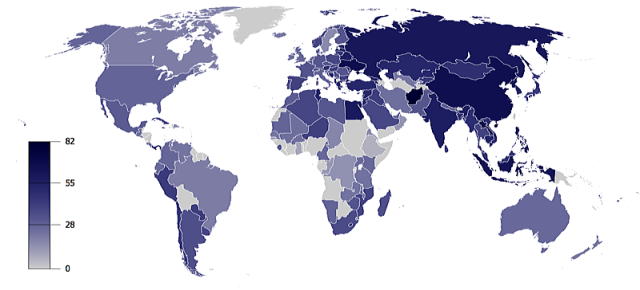
Percentage of males smoking any tobacco product.




NHK Special Program, 'China Power', broadcast on November 22, 2009.
Talk with a movie director with a cigar in his left hand.


Most staff members are smoking and mapping out a strategy how they can
succeed in attracting
many audiences. It contrasts with no-smoking restriction in the indoor
meeting room at Hollywood,
California.
映画大国を目指して動き始めた各界の激変ぶりを描く。ハリウッドで活躍していたジョン・ウー、ピーター・チャン
などの監督達が大挙して中国に活動拠点を移した。香港映画の顔役達も北京に事務所を構え、台湾などのスターが
集結する。東南アジアでは中国ブームが到来し、その存在感は急浮上している。世界中から投資資金が殺到、国民の
団結心を保つためにも大きな期待と役割を担っている。
Dirty Ashtray Award
Over the years, Shanghai has pledged numerous times to prohibit smoking
in public places. However,
we find smokers casually puffing away even inside the city's hospitals.
In fact, a large majority of male
doctors in Shanghai and other parts of the country are smokers. At the
same time, almost none of the city's
government buildings are smoke-free, despite the efforts of Minister of
Health, Chen Zhu and another
100 experts pleading the governments to take the lead in banning smoking
in workplaces in 2007.
No wonder these half-hearted efforts in outlawing smoking and fulfilling
the WHO Framework Convention
on Tobacco Control (FCTC), ratified by the China in 2005, won the infamous
Dirty Ashtray-Award Country,
at the WHO tobacco control conference held in Durban, South Africa. It
was an award for making
a mockery of FCTC guidelines, including preferring better packaging of
cigarettes to the health of its
citizens. None of the packets come with warning labels, such as decaying
teeth or blackened lungs.
Even the mandatory warning words are often too small to be noticed.
Source: China Daily December 20,2008
Health authority in Beijing disclosed that the incidence of lung cancer
is increasing to 57% in the past
10 years,and one-fifth of cancer patients are pulmonary carcinoma (lung
cancer). Lung cancer ranks at
top cause of death from cancer. The Male lung cancer patients are more
prominent ( 1.7 times ),
compared to the female.The disease is resulted from mainly smoking. However,
soot at the time of
cooking and air pollution can be
the cause.
Shanghai will make laws to ban smoking in public places.
It enforced the smoking sites should be equipped with ventilation at indoor
workplaces. Restaurants may
be divided into smoking and nonsmoking areas. Based on these processes,
smoking will be gradually
banned from all public places and indoor workplaces, and second-hand smoking
will hopefully be diminished.
China is the largest tobacco production and consumption country in the
world, and it is as one of the
countries that suffers from the most from tobacco. One million people live
in the China die from the
tobacco related illnesses.
Source: April 1, 2008. China CSR.
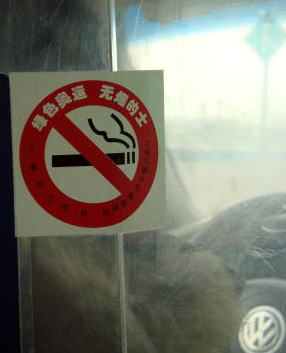
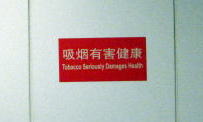

(L) No-smoking sign pasted to the window glass of taxi in Shanghai: Photo
in December 2008
(R) Health warning of smoking
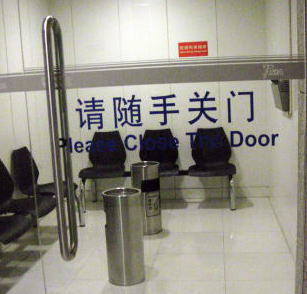

A smoking room in the Shanghai Pudong International Airport: Photo in December
2008
上海浦東国際空港喫煙室と未成年者入室を禁止する喫煙室入口
Real Estate Bubble in China
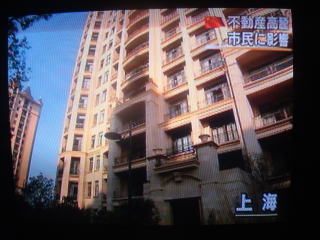

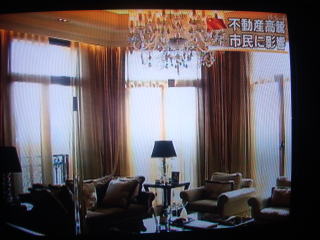



The prices of luxurious condominium are going up to the bubble level.


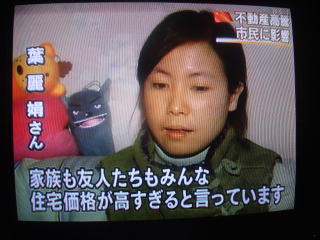
The prices of residence went up 20% in the 10-month period.
Many Chinese people complaining the housing price is too high beyond the
level that they can afford to buy.
Source: NHK BS TV, December 29, 2009.
While newspaper in the U.S. is still filled with reports of foreclosures
and ongoing declines in home
prices, the headlines in China tell a different story. One local daily
reports that in Shanghai, more than
200 potential buyers crammed into the sales office of a new housing development,
snapping up 120 of
the 150 available apartments in just one night. Several weeks earlier in
the central Chinese city of
Wuhan, 300 people lined up to buy newly constructed apartments, some of
them arriving two days
before the sale. A picture in the local press eager customers who brought
chairs and folding beds to
camp outside the sales office with their families.
Such exuberance is both good news and bad news for China's leadership.
The revival of the real estate
industry is a key reason that China's economy is emerging from the global
recession with the strength.
However, frothy increases in home prices are also fueling concerns that
the property boom could turn
into an unstable and dangerous bubble. According to government data, property
prices in 70 cities rose
3.9% in October 2009 from a year earlier, the largest increase in14 months.
In 20 of the cities, prices
jumped more than 1% from the month before. This phenomenon is not limited
to just a handful of the
wealthy coast cities in China.
The reason is that the roaring real estate market is complicating Beijing'sdecision
on when and how to
unwind the drastic stimulus measures that policy makers put in place to
combat the global recession.
There is clearly a link between Beijing's ultra-loose monetary policy and
the run-up in property prices.
The amount of new loans granted by Chinese's banks in the first 10 months
of 2009 surged up 144%,
to $1.3 trillion, from the same period in 2008. This easy money policy
has led to a fantastic increase in
property deals, up to 82% in October compared with the data of the month
of a year earlier. There is
also concern permeating that home prices in major cities are rising out
of the reach of the average
Chinese. It not only could that cause social discontent, but it may also
damp consumption.
Source: Time com. Hong Kong, November 16, 2009.
不動産バブル進行中の中国
中国で再び不動産バブルが引き起こされている。上海では高級高層住宅に買い手が殺到し、価格も1億5000万円
から8億円までの物件が飛ぶように売れている。上海での住宅価格はここ10ヶ月間で20%も上昇した。高値が
高値を呼び転売で利益を得るなどバブルの様相を帯びている。
喫煙人口が世界第1位の3億5000万人。喫煙率は36.0%で、毎年1800兆本のタバコを消費しており、タバコ市場は
3億2000万ドル(約367億円)と非常に大きい。 喫煙が直接・間接的な原因となって死亡する人は年間100万人と
世界で最も多く、この数は2020年に200万人に増えると予測されている。
2008年12月、中国禁煙協会はタバコ税率を現行の小売価格の40%から51%に引き上げれば、喫煙者を1,370万
人減らすことが可能とする研究報告をまとめた。報告によれば、現行のタバコ税率は国際水準の65〜70%を
大きく下回っており、引き上げ余地は大きい。51%の税率で1箱当たり1元の増税となり、政府に649億元の
税収増をもたらす。さらに医療費27億元の削減が見込め、経済全体では99.2億元の利益があるという。喫煙が
社会全体にもたらすコストは1,860億元で、中国のGDPの1.9%。うち、直接の医療負担は140億元で、医療費
全体の3.1%に達している(1元=13.7円、2008年12月現在)。
中国では青少年の喫煙者が1500万人で、タバコを吸ったことがある児童は4000万人。タバコ価格を引き上げれば、
若年層への喫煙抑制効果は大きい。
引用: 中国新聞 2008.12.15 新京報道 2008.12.16
2008年11月、南アフリカのダーバンで開催されていた世界保健機関(WHO)たばこ規制枠組み条約第3回締結国
会議の席上、中国について「禁煙活動に非積極的な国家」と評価し、最も恥ずべき「灰皿賞」を授与した。しかし、
その後、中国政府代表団は参加国の意表を突く形で条約の「タバコ規制に関する公衆衛生政策をタバコ産業の
商業利益および他の既得権益から保護するガイドライン」の支持を表明した。中国政府が自国のタバコ産業との
蜜月関係を断ち切る決意を示したものとして、中国政府代表団が会議場を退出する際には大きな拍手と歓声が
起こった。引用 Record China 2008.11.28
しかし、国として本当にタバコ産業との関係を断ち切ってタバコの写真警告、公共的室内空間の全面禁煙を実行
するのであろうか、今後の動向を注視して行きたい
WHOの会議の席上、世界から非難された中国の喫煙率は36.0%であるが、2008年JTの調査によると、日本人
成人男性の喫煙率は39.5%で、中国人と比べても高い。その中国はすでに国が喫煙規制を始めている。しかし、
日本では国家による受動喫煙規制法の制定には否定的である。2008年12月、自民党政権はタバコ増税案を
拒否した。政権主導部がタバコ依存症にどっぷり浸かっていること、JTなどタバコ販売業界の増税反対が
強固なことなどがその背景にある。日本では20本入り1箱が300円前後と、世界的に見ても、3分の1くらいの
極めて安い価格を維持している。
女性の肺癌(がん)が増加の一途、受動喫煙と調理時の油煙などが主因
中国では男性の肺癌にかかる割合が沈静傾向にあるのに対し、女性の肺癌は増加を続けていることが明らかに
なった。 2009年2月に開催された肺癌治療薬の研究会で、喫煙や受動喫煙、調理時の油煙が女性の肺癌増加の
主な原因になっていると報告された。現在、中国の女性が肺癌にかかる割合は、欧州各国と比べても明らかに
高く、特に上海に住む女性の肺癌発病率は世界平均を大きく上回っており、上海都市部の女性が肺癌にかかる
増加率は男性を上回る。
癌の専門医によると、男性と比べて女性のほうが肺癌になるリスクが高く、同じ条件下で喫煙した場合の危険性は
男性の3倍、今後も肺癌にかかる女性がさらに増える可能性があるという。
引用 新聞晩報 February 20, 2009
肺がん発症率、10年間で57%増―北京市
北京市衛生局副局長は、市内のがん患者の5人に1人が肺がん患者だと明らかにかした。2005年以降、北京市の
肺がん発症率と死亡率は共にがんの中でもトップを占めている。00年から09年までで、北京市の肺がん発症率は
56.35%増加、実にがん患者の5分の1が肺がん患者だという。35歳以上の発症率が高まっており、男女比は172
対100と、男性が1.7倍ほど多い。
毛副局長は喫煙が肺がん発症の最も大きな原因として、肺がんの90%以上は喫煙または受動喫煙によるものだ
と説明する。特に、受動喫煙の肺がん罹患リスクは20〜30%上昇するというから注意が必要である。また、大気
汚染や室内空気汚染、調理時の油煙なども肺がんを誘発する一因だという。
引用:京華時報 November 18, 2011
公共の場所での喫煙に対し罰金を最高200元に引き上げ検討
2008年から北京市では「公共の場所に於ける喫煙禁止令」が実行されており、ホテル、病院、学校、銀行などの公共
施設においての喫煙が禁止されている。北京市では法令の実効性を高めるため違反者に対する罰金を高くすることを
検討しており、現在の10元から最高200元まで引き上げられる模様である。この罰則について市民、6,000人に聞き
取り調査したところ、70%の人が賛成と答えている。
引用 2009.05.18 エクスプロア北京
Smoking Ban in China
 Difficulty in introducing a carpet smoking ban in China.
Difficulty in introducing a carpet smoking ban in China. Smoking declines as tobacco taxes increase
Smoking declines as tobacco taxes increase
 Smoking Ban in a restaurant looks hazy.
Smoking Ban in a restaurant looks hazy.  Smoking Ban in a restaurant appears to fail.
Smoking Ban in a restaurant appears to fail.
 A new smoking ban in Beijing 2015
A new smoking ban in Beijing 2015
 中国喫煙人口 3億5000万人 タバコのよる死亡者は年間100万人以上
中国喫煙人口 3億5000万人 タバコのよる死亡者は年間100万人以上
 2008年12月執筆 2009年2月加筆 2009年5月加筆 2009年12月加筆 2011年11月加筆 医学博士 宮本順伯
2008年12月執筆 2009年2月加筆 2009年5月加筆 2009年12月加筆 2011年11月加筆 医学博士 宮本順伯
★This Web site is link-free.
The article was written in December 2008, and last revised in December
2009,
by Junhaku Miyamoto, M.D., PhD.
Copyright (C) 2008 Junhaku Miyamoto, All rights reserved.
